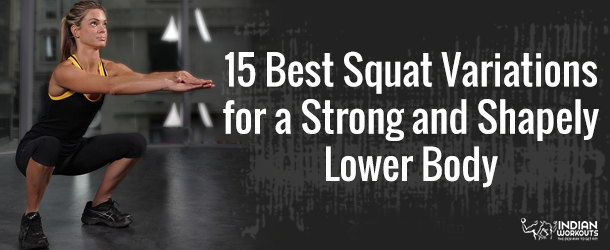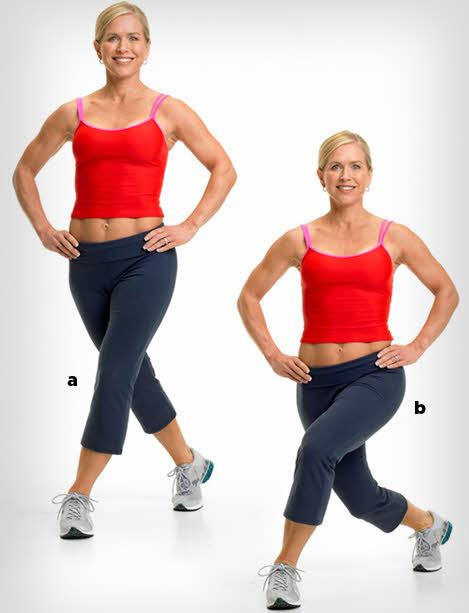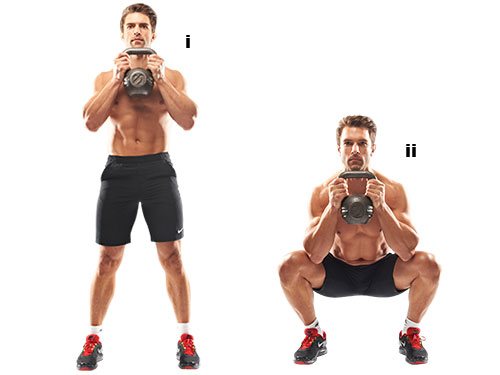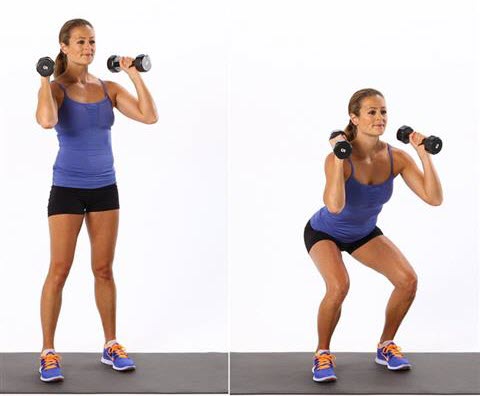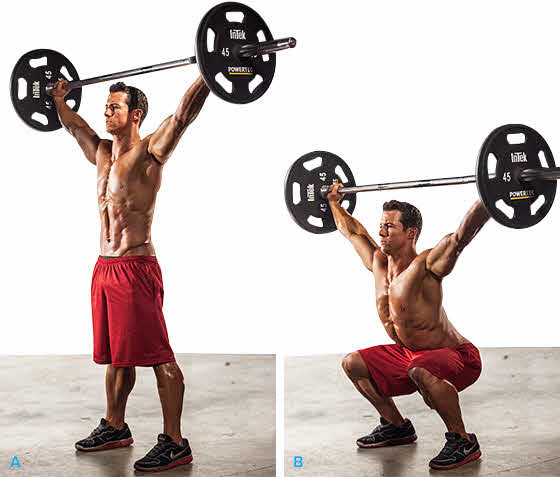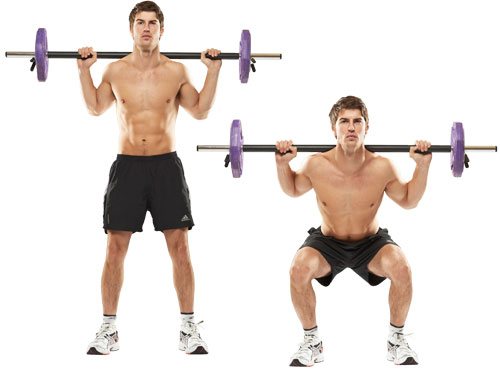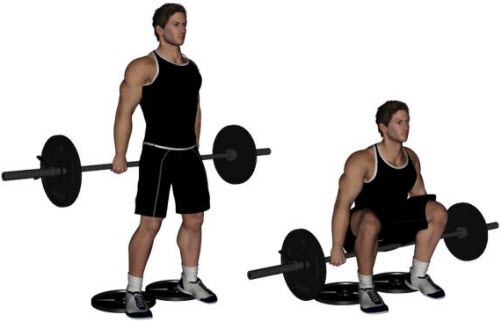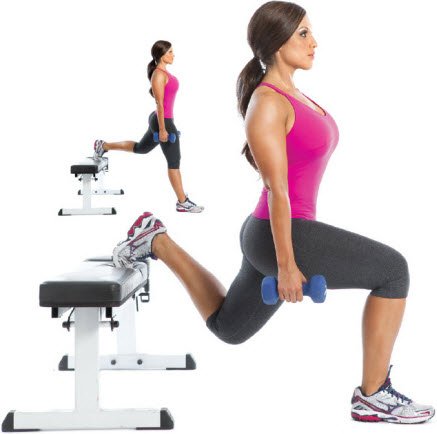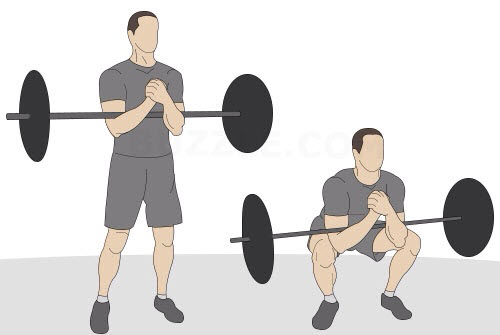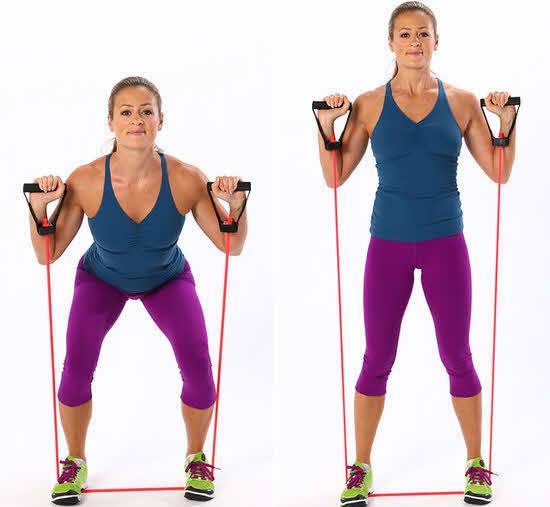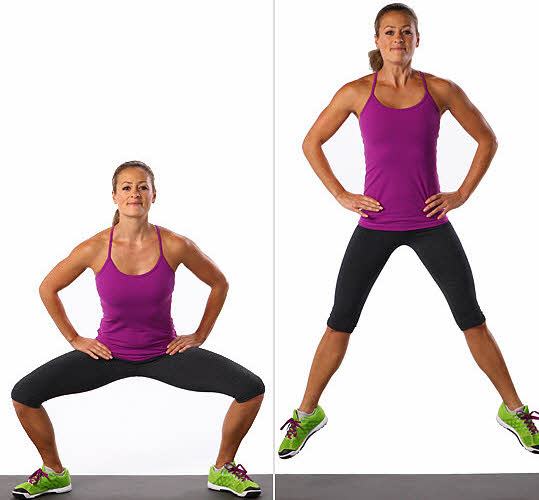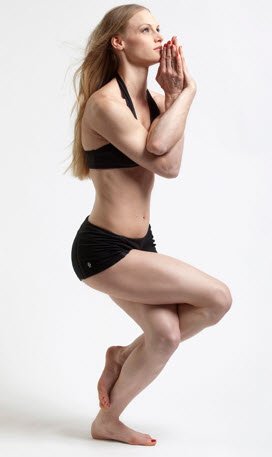If you notice the workout routine of powerlifters, bodybuilders and athletes you will find one thing in common – squats. Squats are one of the favourite exercises of professional athletes and bodybuilders because it not only helps in building insanely strong lower body but also provides a number of other health benefits such as improved flexibility and increase in hormone release. The squat is also a major calorie-burner than helps to cut out the flab from the lower body so it can be practiced by both men and women. In this article, we are going to discuss the popular types of squats and the benefits of doing squats.
The SQUAT is the multi-joint exercise that most gym rats swear by. And what’s more? Even doctors reiterate that it is one of the best exercises which targets a variety of muscle groups throughout your body.
The squat has a number of variations, so you won’t have to get bored by doing the same old exercises.
You will be amazed at the numerous benefits of the squat and the specific muscles and muscle groups that are impacted when you perform it.
So have you decided to include squats into your exercise regime? Not yet? Then here are a few more reasons to convince you to squat, and squat low at that. Squat impacts these four main muscles.
Erector Spinae
Although squats are not regarded as a back exercise, the erector spinal muscle group contracts isometrically and does not shorten and lengthen during the downward movement and upward movement phases of the exercise.
Now, how will you find the erector spine group? This group of muscles, which includes the iliocostalis, longissimus and spinalis muscles, span the entire length of your back on both sides of your spine, attaching to the various inside structures.
These muscles help with lateral, or sideways, spine flexion and also torso rotation ranges of motion.
Gluteus Maximus
The next muscle group which you can target by doing the squat exercise, is the gluteus maximus muscle.
It is the largest of the gluteal muscle groups, which includes both the gluteus medius and gluteus minimus muscles. It helps in the hip extension movement along with the hamstrings on the back of your thigh.
Hamstrings
The three muscles that constitute the hamstring muscle group are the biceps femoris, semimembranosus, and semitendinosus. They are activated when you perform squats.
The hamstrings help the gluteus maximus muscle with hip extension, so they function eccentrically during the downward movement phase and concentrically as you return to the starting position, while you perform the squats.
Quadriceps
The rectus femoris or the vast intermedium, vastus lateralis and vastus medialis muscles are together known as the quadriceps muscle group.
The quadriceps muscles increase the angle between your lower and upper legs. The quadriceps contract eccentrically while you do the downward movement of the squat and concentrically while doing the upward movement phase.
6 Amazing Benefits of Doing Squats
Let us look at the wonderful benefits of this modest bodyweight exercise before getting on with the different types of squats.
Stronger Lower Body
This is the basic advantage of doing squats, but it is worth a special mention because squat variations work more effectively than machine exercises like leg extensions and leg curls in working the leg muscles. The squats target all the lower body muscles including the quads, hamstrings, glutes and calves in unison that is required to build real-world strength. It also corrects potential strength imbalance between the left and the right side.
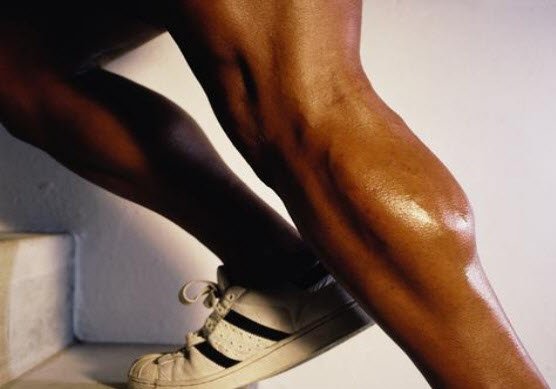
Boosts Hormone Release
The different types of squats work as total body exercises that stimulate the release of muscle-building hormones and growth hormone such as testosterone. The inclusion of a challenging weight in the squat helps to make the most out of the anabolic hormonal benefits that help in bulking up.
Improves Core Strength
Because squat exercises engage the muscles from top to bottom, so the core is worked double-time – to prevent injury and to maintain an upright posture throughout the workout. It helps to build six-pack abs and improve core strength.
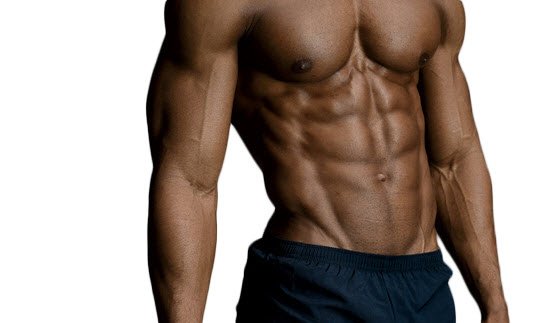
Enhances Flexibility
Performing squats provides a full range of motion by strengthening the leg muscles at all points and increasing mobility in the entire hip complex. The advantages of increased flexibility are reduced back pain, swiftness in getting around in daily activities and improved sports performance.
Burns Fat Faster
Muscles burn fat at a fast pace and more muscles means less fat. The squat is one of the most efficient exercises for packing on muscle mass and the more muscles you have, the more calories you will burn during each training sessions. Squats help you to get a lean and toned frame.
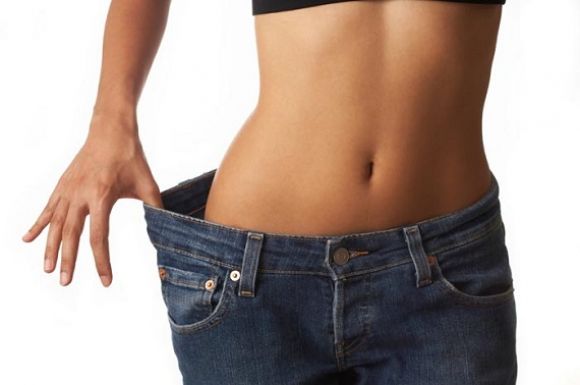
Lower Risk of Injury
Squats help to strengthen the muscles surrounding the knees and hips such as glutes, hamstrings and quads that work as primary stabilizers and reduce the chances of injury while jumping, running or lifting heavy weights.
Other Benefits of Squats
Helps Bid a Firm Good-Bye to Cellulite
What is the one exercise that stretches the muscles, gets your blood pumping throughout your entire body and also improves your overall health? No prizes for guessing, it is squats!
With more nutrients and oxygen reaching the vital organs and muscles of your body, thanks to good circulation; those ugly cellulite marks you are so not in love with can finally go.
Digestion troubles? Try Squats!
Squats are a great way to enhance elimination. The squat exercise eases the flow of fluids in your body and enables the passing of waste through your bowels, so this is one way to stay regular.
It is not for building your calf muscles only.
Okay, we know that squats are great for building leg muscles, but the good thing is that it promotes muscle growth around your entire body.
The exercise creates an anabolic environment that makes the body proliferate hormones that help in the growth of muscle tissue; squats strengthen both the upper and lower body.
Squats are great for your back and do not strain your back.
Other exercises can put a strain on your knees, ankles, and back, but performing squats do not have this effect. But you have to do it the right way, to prevent injuries.
You do not need any fancy equipment or the gym to perform the exercises.
Thank God for an exercise that can be performed just about anywhere! So, you can do squats within the four walls of your home and also out in the park.
Your posture improves drastically with squats
Squats also improve posture and balance. This new found balance and posture help sit, stand and walk tall and straight. It will also strengthen your back muscles and avoid the pains and niggles associated with continuous stooping.
Squat exercises help you lose weight
Wow, now isn’t that just great? Squats help burn calories too! It tones you up and helps in burning calories, so go ahead squat your way to good health and fitness. If you are trying to lose those stubborn extra kilos, squat you must!
Squats improves flexibility and also prevents injuries
They’re among the best knee exercises to help strengthen and stretch your knees. It allows more blood to flow around the joints keeping them supple and strong.
Helps you get those perfectly toned legs
Squats are not for any specific muscles, but help tone your entire leg! It is the most comprehensive workout to work on the muscles of your legs.
Get a pert round butt
If you want to slip into those skinny jeans and look good while wearing them, then squats are the way to go. They firm up your buttocks and give you the silhouette
15 Different Types of Squats for a Toned and Muscular Lower Body
Adding squats to your regular workouts is a great way to strengthen the hamstrings, glutes, quadriceps and hips and it also helps in reducing the chances of knee injuries. Here is a list of the 15 different squat variations that range from all important categories such as weighted, with equipment, basic bodyweight and plyometric.
Standard Squat
Let us begin the list of best squat exercise variations with the standard squat that is a basic body weight exercise that works the leg muscles and helps in increasing lean muscles mass through its catalyzing and anabolic effect. It also helps to promote mobility and balance that helps to improve sports and athletic performance.
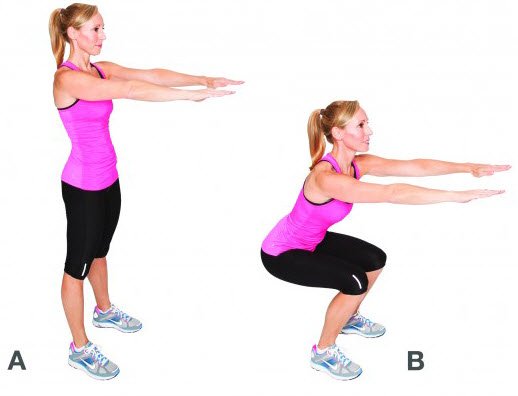
Begin in the standing position with your feet placed hip-width apart, toes pointing forward, neck straight and abs engaged. Hold the arms straight in front of you with palms facing down. Now, bend your knees and lower yourself down till the top of the thighs are parallel to the ground. Push the butt backwards and remain in the position for a few moments and then return to the standing position.
Pistol Squat
The pistol squat is considered one of the most difficult squat variations that are also an amazing lower body exercise. It can be a bit tricky to master this squat, but the results are worth the effort. They are the best exercise for strong, toned and athletic legs that are necessary for maintaining the symmetry of a muscular upper body.
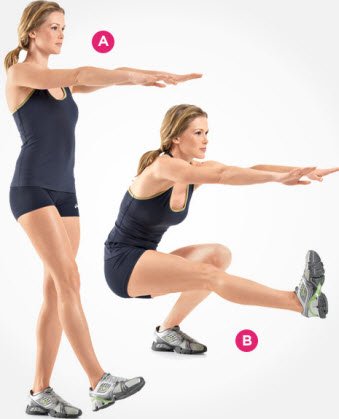
Start with your feet placed hip-width apart, raise one leg straight out in front of you and slowly squat down till your butt is almost touching your heel. Now, stand up without using your lifted leg.
Plié Squat
The plié squat is a barre-inspired exercise for the lower body that tones not only the butt but also the major back muscles so that you can rock and backless number with confidence. You can use a dumbbell in this squat to make it more intense.
Start in the standing position holding one dumbbell at either end with both hands and your feet placed slightly wider than hip-width apart. Keep your toes turned out about 45 degrees. Now, lift your heels off the floor and bend your knees while balancing on the balls of your feet. Lower your body down keeping the back straight, slowly come back up and lower the heels.
Sumo Squat
Next in line is the sumo squat that is one of the killer glute exercises that also engages the quadriceps, hamstrings, hip flexors and calves. The sumo squat puts more stress on the inner thigh adductors and helps to improve your balance.
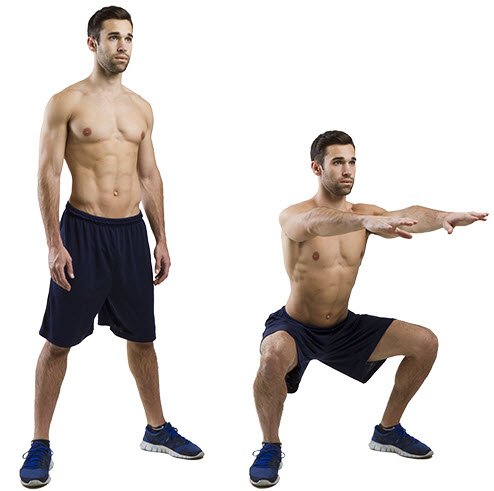
Stand with your feet placed wide apart, toes pointed slightly outside, and arms raised straight in front of you. Push your hips back and come to a squatting position by bending your knees. Squat down till your thighs are in line with your knees. Come back to the initial position by pushing through the heels.
Curtsy Squat
The Curtsy Squat is one of the most effective butt exercises for women who are trying for a tighter bottom. It is the ideal way to tone the legs and glutes without putting too much pressure on the joints.
Begin with your feet placed hip-width apart and hands resting on the hips. Now, bring your right foot behind the left one as far past your left foot as possible. Now, squat down with a curtsy motion maintaining your body weight on the front leg and then return to the starting position.
Goblet Squat
The goblet squat is an explosive exercise for legs which is frequently included in the list of best kettlebell workouts. It is a fundamental exercise that helps to perfect the squat form that activates the glutes and hips and strengthens the upper back muscles.
Stand with your feet placed hip-width apart holding a kettlebell in front of your chest with both hands and the elbows pointing towards the floor. Push your butt back and squat down by bending your knees till the thighs are almost parallel to the floor and elbows at touching insides of the knees. Wait for a few moments and the push yourself back to the starting position.
Dumbbell Squat
Dumbbell squats are one of the functional lower body exercises that are considered the perfect squat exercise in many ways. It targets the quads, glute muscles and hamstrings and burns a substantial number of extra calories. It also helps to improve flexibility and avoid sport-related injuries.
Stand with your feet placed hip-width apart holding a pair of dumbbells so that your palm faced each other, resting the dumbbell heads on each shoulder. Now, push your hips back and bend down keeping your body as upright as possible. Squat down till the thighs are parallel to the floor, wait for a few seconds and the push yourself back to the starting position.
Overhead Squat
Overhead squat is one of the best lower body workouts for men that are useful for training the lower body while improving balance and mobility at the same time.
Take a wide hold on a barbell and raise it overhead. Now, perform a squat while keeping the barbell over your center of gravity and then come back to the starting position. Overhead squats require a certain degree of shoulder mobility to perform it with perfection.
To do it right
- Place a bench or low box right behind you in a squat rack.
- Place a relatively light barbell across your upper traps as you normally place for squatting, and unrack the bar.
- Lift one foot up behind you and place it firmly on the bench with care.
- Stand tall and straight with your chest out, back slightly arched, and back leg bent around 90 degrees.
- Bend your front leg and then lower yourself down toward the floor as if you are sitting down on a stool. When your thigh is parallel to the floor, press through your heel and return to the standing position.
Barbell Squat
The barbell squat, also known as Olympic squat is one of the power-packed hamstring exercises that also work the glutes, calves and lower back muscles. It not only helps in toning the muscles and burning calories but also aids in strength training and muscle building. It is best to perform this exercise inside a squat rack for safety purposes.
Set the barbell on a rack just above shoulder level and step under the bar, placing the bar on the back of the shoulders. Now, hold the bar with both arms, lift it off the rack and perform a squat by bending the knees till the hamstrings are on the calves. In have as you squat down and exhale as you raise the bar up by pushing through the heels.
To do it right
- Pull your hips back and keep your weight on your heels.
- Pull the bar back in a way that you keep the weight directly over your heels.
- Do not let the bar move forward or behind at any point of the movement.
- Ensure that your hips reach a point below the top of your knee (below parallel).
- Keep your weight on your heels and stand to full extension.
- Squat down slowly and then push up and slightly back on the bar.
- Keep your torso erect and then let your hips go backward a bit.
- When you stand up, keep pushing up and back until you are able to stand erect.
Hack Squat
Hack squat is one of the functional exercises for thighs that helps to improve the strength of the thighs and quadriceps along with a lack of spinal compression. This exercise combines the benefits of deadlifts and squats.
Stand in front of a barbell with your feet placed flat on the floor and heels slightly raised on a slab. Now, squat down and grab the barbell from behind with and overhand grip and stand up which keeping your chest straight and back arched.
Bulgarian Split Squat
The Bulgarian split squat is an advanced unilateral exercise and one of the useful squat variations for glutes that requires no equipment. It is a wonderful fat burner that also helps to develop better abs and hips.
Stand before a bench or raised platform with one foot placed on the bench. Now, squat down by pushing the hips back and keeping the torso upright while bending the raised leg at the knee. Bend down till you reach the bottom position where your back knee touches the ground then come back to the starting position.
Zercher Squat
This is an explosive squat variation that helps to tone the torso and enhance core strength with minimal spinal compression. This exercise must be included in the workout routine of athletes and powerlifters to enhance muscular development and strength. It is a solid exercise for the hamstrings and glutes.
Place a barbell on the rack just lower than the level of your sternum. Now, hook the elbows under the bar and pull it upwards and then squat down till the elbows are between your knees and the bar is touching your thighs, wait for a few moments and raise up.
To do it right
- Set up the bar on a rack.
- Reach your forearms out in front of your body, keep your elbows bent and place the bar on top of upper forearms.
- Move away from the rack and position your legs keeping a shoulder width stance with your toes slightly pointed out.
- Lower the bar while bending the knees and maintain a straight posture with your head up.
- Continue to go down until the angle between the upper leg and the calves is less than 90-degrees.
- Come back to the starting position.
Resistance Band Squat
This is one of the best and easiest resistance band exercises that help to build a shapely butt. The force applied by the band increase the difficulty level of the squat exercise and makes it more challenging.
Loop a resistance band around your legs, placing it just under the knees. Push the knees out against the band to keep it stable and now lower down to a squat till the thighs are parallel to the ground. Now, take one step to the side at this position and then one step to the back and then alternate the movement.
Squat Jump
The squat jump is a versatile plyometric exercise that helps to build speed, strength, power and force development. It not only works the leg muscles harder but also adds cardio benefits to your strength training.
Start in a squat position with your thighs parallel to the floor and the hands placed on the hips. Now, jump up explosively in the air and land on your feet and squat down immediately and jump up again. You can swing your arms for momentum.
Eagle Squat
Last but not the least is the majestic eagle squat that has been inspired by the classic yoga pose known as the eagle pose or “Garudasana” that helps to boost flexibility, strength and endurance. It makes the squats more interesting and challenging.
Stand with your feet close together and arms stretched out on the sides. Now, bring your right leg over your left leg and wrap the right foot around the back of the left calf. Bring the right elbow under the left elbow and wrap the right hand around the left forearm so that the palms join. Once you gain balance, squat down as low as you can and then return to the standing position.
Other Squat Exercises that you should not miss out
Split squat
Split squats are not paid enough attention to, but are a great variation as they help alleviate right-to-left side imbalances, increase stability and coordination, and can even help with two-leg version. This exercise is tough to look at, so try and master it first before you think of increasing the repetitions.
To do it right
- Place a bench or low box right behind you in a squat rack.
- Place a relatively light barbell across your upper traps as you normally place for squatting, and unrack the bar.
- Lift one foot up behind you and place it firmly on the bench with care.
- Stand tall and straight with your chest out, back slightly arched, and back leg bent around 90 degrees.
- Bend your front leg and then lower yourself down toward the floor as if you are sitting down on a stool. When your thigh is parallel to the floor, press through your heel and return to the standing position.
Front Squat
Front squat is an exercise that keeps the bar in front you instead of on your back. This works on the quadriceps harder than the hamstrings and requires core strength and also keeps an upright position compared to the back squat.
To do it right
- Grasp hold of the bar closed in an overhand grip and keep it slightly wider than shoulder-width.
- Place the bar evenly on top of your front deltoids and also your collarbone.
- Keeping a relaxed open palm and 3 fingers under the bar, remove your thumb and pinky finger from under the bar.
- Take a step or two backward, while taking a step or two backward. Inhale and hold that breath towards the bottom to keep your abdomen tight. Flex your hips and knees slowly. Drive your knees outwards as you squat.
- Continue to squeeze the elbows up and inwards and focus on keeping your elbows up at the bottom of the lift.
- Once you’ve reached the parallel, drive upwards keeping your heels on the floor and knees aligned with feet. When you are halfway up, exhale and power through with the glutes and your core tight and braced in.
One Legged Squat
The pistol squat or the single-leg squat, is an effective exercise that combines strength, flexibility, and grace. This exercise needs proper execution and mastering each element.
To do it right
- Begin with your arms extended out in front of your body.
- Balance your body on one leg with the opposite leg extended straight in front as high as possible.
- Squat down low as far as possible and keep the elevated leg off the floor. Keep your straight and keep the supporting knee pointed in the same direction as your supporting foot.
- Lift your body back up to original position until your supporting leg is straight.
- Repeat and switch to the other leg.
What’s the use of a massive upper body if you have skinny legs? So, try out these effective squat exercises and add some muscles to your legs and have a toned and chiselled lower body.
